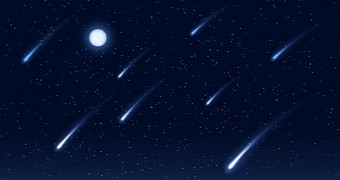The Perseid shower will peak tonight, and with some luck, dozens of meteors will illuminate the night sky over the Northern Hemisphere.
Between the late hours of August 12 and early morning on August 13, meteors will be visible at a rate of about 70 to 100 per hour.
Since August 14 will be a new moon, the light display will be all the more impressive, what with the sky being especially dark this time around.
The Perseid meteor shower will reach its peak at about 1 a.m. PT / 4 a.m. ET. So, yes, you'll have to make an effort to stay awake if you want to see it.
“They rise soon after sunset, but you'll want to wait til they are higher in the sky to see the most meteors,” NASA astronomers explain.
“The best meteor watching hour is 4 a.m. Eastern or 1 a.m. Pacific time on the morning of August 13, when up to 100 meteors per hour may be visible from a dark sky,” they further detail.
The Perseids happen every year
The Perseid meteor shower happens each year as our planet crosses paths with debris left behind by a comet by the name of Swift-Tuttle.
The first meteors usually streak across the sky towards the end of July. Then, after peaking in mid-August, the shower lasts for a few more days before fading.
This year, the first meteors birthed by Swift-Tuttle were documented on July 19. The last of the bunch will make an appearance around August 24, after which it'll be lights out until next summer.
The reason the shower is called the Perseids is that, when emerging in the sky above the Northern Hemisphere, the meteors seem to originate from the constellation of Perseus.
Although the shower is yet to reach its peak, space enthusiasts have already pointed their cameras at the sky and managed to photograph a handful of meteors. Lucky us, they shared their work on social media.
This #Perseids Meteor was woohoo! Green and bright flash ending! #PerseidMeteorShower #explorealberta pic.twitter.com/P9G1E4pF0Y
— Neil Zeller (@Neil_Zee) August 12, 2015
Fab #PerseidMeteorShower photo taken by @BobMorgans - top #BreconBeacons spots to watch are https://t.co/10m3yVPyfy pic.twitter.com/lKDOYrNc1f
— BreconBeaconsTourism (@BBNatPark) August 12, 2015
Another late night with the camera, but worth catching #PerseidMeteorShower @darkskyobs @RoyalObs @RoyalAstroSoc pic.twitter.com/QvWSZyAcqu
— Kit Carruthers (@MrKitCarruthers) August 12, 2015
3 cameras capture of very bright #meteor tonight. #meteorwatch #PerseidMeteorShower pic.twitter.com/P1m1IhAY2w
— UK Meteor Network (@UKMeteorNetwork) August 8, 2015

 14 DAY TRIAL //
14 DAY TRIAL //